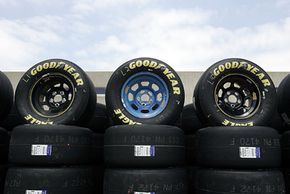Goodyear Racing Eagles
Goodyear Racing Eagles share many of the same features found in street tires. To see a complete breakdown of street tires, read How Tires Work. However, several components are unique to racing tires and in particular, Goodyear Racing Eagles:
- Apex - controls the stiffness, or rigidity, of the sidewall
- Bead - the area of contact between the tire and the rim (Racing Eagles can have two beads, depending on the track and the tire)
- Carcass Piles - act as the backbone of the tire, providing support and delivering strength to the top of the tire
- Belt Package - Steel braided belts are placed between the tread and piles to give the tire its flat footprint
- Inner Liner - An inner tire that provides support in the event of a puncture or failure to the outer main tire
- Tread Compound - The part of the tire that provides grip -- the contact patch
The most noticeable difference between a Racing Eagle and a Goodyear Eagle F1 street tire is the tread. Racing Eagles have no tread. But don't be fooled. Just because Racing Eagles don't have any tread doesn't mean they lack grip. Racing Eagles are what's known as a slick. Slicks are racing tires with smooth surfaces. The most fundamental method of providing mechanical grip in a race car is to put as much surface area of the tire in contact with the road, or track surface, as possible. Because slicks have no grooves, they have a larger contact patch, or footprint, and provide optimal traction.
Advertisement
A lot of effort goes into building a tire. One of the processes the tires go through involves curing. The curing process gives the tires their desired compound, but racing tires are under an extreme amount of heat and stress at all times and that can change the way a tire grips during a race. As we'll learn later, heat can play a large role in tire performance.
If you've ever watched a NASCAR race before, chances are you've heard the term sticker tires. Sticker tires are nothing more than a brand new set of Goodyear Racing Eagles. The reason crew chiefs, drivers and fans refer to new tires as sticker tires is because of the large data sticker label on the tire. NASCAR teams do not remove the sticker from the tire before they mount them onto the race cars, so when teams turn to a new set of tires, they grab sticker tires. The sticker contains valuable information including spring rate, which is simply another term for tire stiffness, tire code and sequence number. NASCAR teams often try to match tire numbers in sequence to get what they believe to be the most similar tires on the car at the same time. Many teams believe matched tires that come from the same batch will perform consistently together.
In the next section we'll learn how tire testing works and why NASCAR teams are waiting in line to get their hands on Goodyear Racing Eagles.
